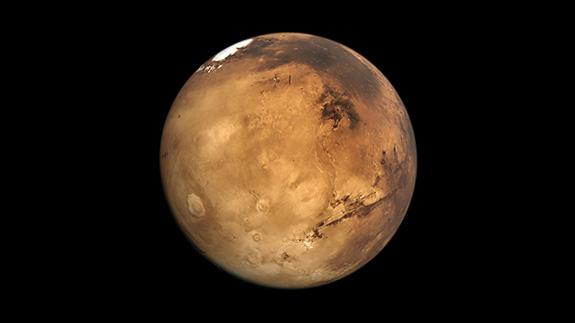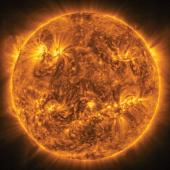Mars Attacks
Summer's alien invasion.
No one would have believed in the last years of the nineteenth century that this world was being watched keenly and closely by intelligences greater than our own… (that) across the gulf of space…. intellects vast and cool and unsympathetic regarded this earth with envious eyes, and slowly and surely drew their plans against us. —H. G. Wells, The War of the Worlds
This summer, when you’re sitting around a wilderness campfire, stirring the red coals, look up for the blazing red coal in the sky, and think of old H.G. For this is the summer of Mars.
Every two years and two months, the faster Earth in its smaller orbit “passes” its more distant, slower cousin. The time when Earth laps the Red Planet is known as “opposition.” The two planets are closest to each other on the same side of the sun; Mars lies opposite the sun in our sky, rises at sunset, and looks biggest in our telescopes and brightest in our sky.
Opposition occurs on July 27. The full moon will rise with Mars, both against the stars of the constellation Capricornus, to the east of the teapot pattern of Sagittarius. It will be unmistakable, for nothing in the night sky will be brighter except the moon and Venus, shining low in the west at nightfall. Mars will briefly outshine even Jupiter, which sulks in the south in Libra, west of the fishhook shape of Scorpius.
Because Mars will also be near its perihelion—its closest point to the sun—this opposition will be particularly favorable; it lies a “mere” 36 million miles away. This will be its brightest (and biggest-looking) since 2003. It will be prominent during the late night all summer long, and telescopes will more easily spy its dark features and a small southern polar cap in what will be spring in the Martian southern hemisphere.
It was around opposition that Wells, in his 1897 serialized novel The War of the Worlds, sent his predatory Martians to Earth, because orbital logistics make it easiest to do so at this time. Earth’s invasion fleets of spacecraft have done the same; our current commando force of rovers poking around the surface and orbiters surveilling from above were all sent in opposition years.
As of this writing, we’re planning to do it again. NASA’s Mars Insight lander is scheduled for launch in early May. If all goes well, it will land on Mars in late November, where it will insert a probe into the surface and listen for marsquakes to study its interior and help us understand how rocky planets—including Earth—form.
Even though invasions have been a one-way affair favoring Earth, Mars does take its pot shots. Past impacts have sent fragments of its surface flying into space, and they occasionally hit Earth. If you’d like to get closer to Mars than 36 million miles, visit the Museum of the Rockies in Bozeman. In front of the planetarium, you’ll find an exhibit case containing a bouillon-cube-sized piece of the Zagami meteorite. The original 40-pound rock nearly hit a farmer near Zagami, Nigeria in 1962; analysis showed it to be Martian in origin.
This summer, when your trail takes you to overnights under a dark sky, pack a copy of Wells’s book, still a kicking good yarn, watch for baleful red Mars to rise over the eastern pines, and enjoy!
Jim Manning, formerly the executive director of the Astronomical Society of the Pacific in San Francisco, lived outside Bozeman for many years and has returned to live here once again.












